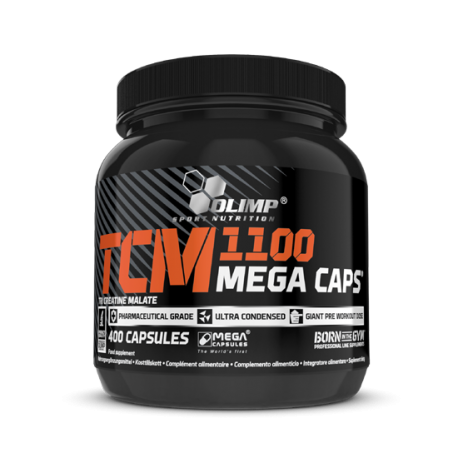Tri Creatin Malat
Filter
-
 Jetzt 11% sparen
Jetzt % sparen
Original-Preis €49,90Original-Preis €49,90 - Original-Preis €49,90Original-Preis €49,90Aktueller Preis €44,41€44,41 - €44,41Aktueller Preis €44,41|/
Jetzt 11% sparen
Jetzt % sparen
Original-Preis €49,90Original-Preis €49,90 - Original-Preis €49,90Original-Preis €49,90Aktueller Preis €44,41€44,41 - €44,41Aktueller Preis €44,41|/TCM 1100 Mega Caps · 400 Kapseln
Olimp Sport Nutrition1 reviewMikronisiertes Creatinmalat für maximale Absorption und Nutzung Positive Effekte: verbesserte Muskelenergieversorgung, Muskelausdauer, Unterstützu...
Vollständige Details anzeigenOriginal-Preis €49,90Original-Preis €49,90 - Original-Preis €49,90Original-Preis €49,90Aktueller Preis €44,41€44,41 - €44,41Aktueller Preis €44,41|/Jetzt 11% sparen Jetzt % sparen
Was ist Tri-Kreatin Malat?
Synonyme: Tri-Creatin Malat, Tri-Creatine Malate
Kreatin ist eines der beliebtesten und effektivsten Sportsupplements, das der Markt zu bieten hat und es konnte wieder und wieder wissenschaftlich bewiesen werden, dass es Kraft, Ausdauer und sportliche Leistungsfähigkeit steigern kann (1). Bei Kreatin handelt es sich um eine Aminosäure, die hauptsächlich in der Skelettmuskulatur an Phosphationen gebunden gespeichert wird und zur Wiederauffüllung der ATP Speicher der Zellen verwendet wird. ATP ist das Molekül, das die Muskulatur mit schnell verfügbarer Energie versorgt (2).
Die am häufigsten verwendete Form von Kreatin ist Kreatin Monohydrat. Bei der Monohydrat Form ist jedes Kreatin Molekül an ein Wassermolekül gebunden. Tri-Kreatin Malat ist eine andere Kreatinform, bei der drei Kreatinmoleküle an ein Molekül natürlich vorkommender Apfelsäure (Malic Acid) gebunden sind, was Tri-Kreatin Malat etwas andere Eigenschaften als Kreatin Monohydrat verleiht.
Woher stammt Tri-Kreatin Malat?
Sowohl Kreatin, als auch Malat (Apfelsäure) kommen natürlich im menschlichen Körper vor. Kreatin wird von Leber und Nieren produziert und außerdem in Form von Nahrungsmitteln – insbesondere Nahrungsmitteln tierischen Ursprungs – von außen zugeführt. Malic Acid oder Apfelsäure ist ein wichtiger Teil des Stoffwechsels und wird im Körper im Rahmen des Prozesses der Energiebereitstellung produziert. Apfelsäure wird von allen lebenden Organismen produziert und ist für den sauren Geschmack von Obst wie Rhabarber und grünen Äpfeln verantwortlich. Diese beiden natürlichen Komponenten werden bei Tri-Kreatin Malat synthetisch kombiniert, um eine neue Kreatinform zu generieren.
Vorzüge von Tri-Kreatin Malat
Es ist davon auszugehen, dass Tri-Kreatin Malat dieselben Vorzüge wie Kreatinkomplexe besitzt, bei denen Kreatin an andere Moleküle gebunden vorliegt. Diese Vorzüge wurden bereits ausgiebig in unserem Kreatin Profil behandelt.
Malat ist an der Generierung von Energie über eine aerobe Oxidation beteiligt. Dieser Prozess läuft bei allen atmenden Organismen ab und dient der Umwandlung von über die Nahrung zugeführten Kohlenhydraten, Fetten und Proteinen in ATP und andere Substanzen.
Tri-Kreatin Malat wird häufig mit dem Argument vermarktet, dass es sehr gut in Flüssigkeit löslich ist und im Vergleich zu Kreatin Monohydrat vom Körper leichter absorbiert werden kann, während es gleichzeitig weniger potentielle Nebenwirkungen wie Wassereinlagerungen oder Magenverstimmungen besitzt. Einige Leute behaupten, dass bei Tri-Kreatin Malat im Gegensatz zu Kreatin Monohydrat keine Ladephase notwendig ist.
Vorzüge von Tri-Kreatin Malat für Bodybuilder
Kreatin ist dafür bekannt, dass es bei Kraftsportlern Leistungsfähigkeit und Kraft steigert. Kreatin sammelt sich in den Muskelzellen an und schafft ein Reservoir von Phosphationen, welche dazu in der Lage sind, ATP in den Zellen zu regenerieren. Dies bedeutet, dass die Muskeln über mehr Energie verfügen, um mehr Wiederholungen absolvieren zu können (2). Kreatin kann außerdem die Glykogenspeicherung anregen, wodurch sichergestellt wird, dass die Muskelzellen über eine langfristigere Energiequelle verfügen und es kann auch bei der Säurepufferung der Zellen eine Rolle spielen (3). All dies bedeutet, dass die Muskeln dazu in der Lage sind, über einen längeren Zeitraum härter zu arbeiten.
Darüber hinaus kann Kreatin die Ausschüttung anaboler Wachstumsfaktoren fördern, welche eine Muskelhypertrophie anregen (4). Mit Kreatin Monohydrat durchgeführte Studien zeigen regelmäßig Vorzüge von Kreatin bei Leistungssportlern und Bodybuildern und Kreatin ist nicht ohne Grund eines der beliebtesten auf dem Markt erhältlichen Supplements.
Tri-Kreatin Malat Nebenwirkungen, Sicherheit und Nachteile
Auch wenn es eine sehr große Menge an Studien gibt, die die Wirkungen von Kreatin Monohydrat belegen, sind nur sehr wenige wissenschaftliche Informationen über Tri-Kreatin Malat verfügbar. Man kann jedoch unter Berücksichtigung der biochemischen Natur der Verbindung und der anekdotenhaften Berichte mir gutem Gewissen annehmen, dass Wirkungen und Nebenwirkungen von Tri-Kreatin Malat und Kreatin Monohydrat ähnlich ausfallen. Bisher gibt es noch keine wissenschaftlichen Untersuchungen, die die Behauptung stützen, dass Tri-Kreatin Malat besser aufgenommen wird oder weniger Nebenwirkungen besitzt. Nebenwirkungen, die gelegentlich bei einer Verwendung von Kreatin Monohydrat beobachtet werden können, umfassen Wassereinlagerungen und Magenverstimmungen und es ist wahrscheinlich, dass diese Nebenwirkungen auch bei Tri-Kreatin Malat auftreten können.
Tri-Kreatin Malat Dosierung
Die empfohlene Einnahmemenge variiert bei Kreatin Malat von Hersteller zu Hersteller, liegt aber für gewöhnlich zwischen 3 und 5 Gramm pro Tag. Wie bei Kreatin Monohydrat kann diese Dosis auf mehrere Einzelgaben aufgeteilt werden, um mögliche Nebenwirkungen zu reduzieren.
Tri-Kreatin Malat Supplements
Tri-Kreatin Malat wird sowohl als Monopräparat, als auch als Bestandteil einer Reihe von Pre-Workout Supplements und Kreatinmischungen verkauft. Es findet sich auch in einigen Weight Gainern und Proteinpulvern wieder.
Kombinationen von Tri-Kreatin Malat
Wie andere Kreatinformen wird auch Tri-Kreatin Malat am besten in Gegenwart von Insulin absorbiert, weshalb eine Kombination mit einfachen Kohlenhydraten der einfachste Weg ist, das meiste aus diesem Supplement herauszuholen.
Referenzen
- Bird, Stephen. "CREATINE SUPPLEMENTATION AND EXERCISE PERFORMANCE: A BRIEF REVIEW". www.jssm.org.
- Hespel, P; Eijnde, BO; Derave, W; Richter, EA (2001). "Creatine supplementation: Exploring the role of the creatine kinase/phosphocreatine system in human muscle". Canadian journal of applied physiology = Revue canadienne de physiologie appliquee. 26 Suppl: S79–102
- Rawson E, Persky A (2007) Mechanisms of muscular adaptations to creatine. Int Sport Med J 8:43–53
- Olsen, S.; Aagaard, P; Kadi, F; Tufekovic, G; Verney, J; Olesen, JL; Suetta, C; Kjaer, M (2006)."Creatine supplementation augments the increase in satellite cell and myonuclei number in human skeletal muscle induced by strength training". The Journal of Physiology 573 (2): 525–34.

